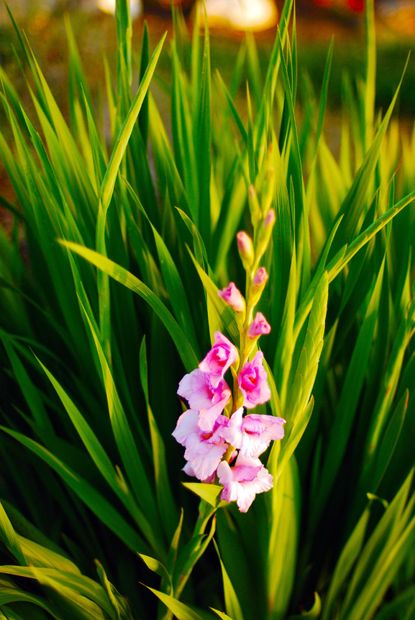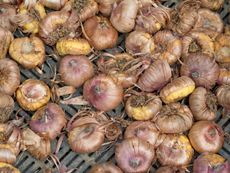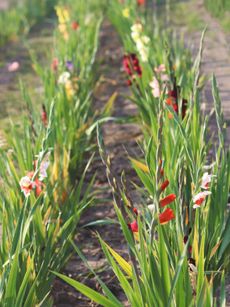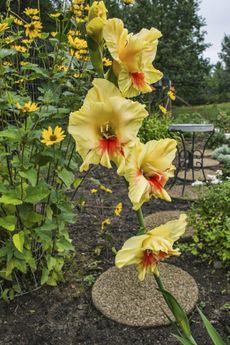Gladiolus Not Blooming: Tips On Getting A Gladiolus Plant To Bloom


Gladiolus plants are lovely spikes of color that grace the landscape in summer. They are not very winter hardy and many northern gardeners may experience the frustration of their gladiolus not blooming after the cold season. If you have had occasion to ask why your glads did not flower, get some answers on the variety of reasons for no blooms on gladiolus here.
Reasons Glads Did Not Flower
Gladioli grow from corms, which are underground storage organs much like bulbs. Glads thrive in sunny warm areas of the garden with good drainage and rich organically charged soil. The corms should be healthy at planting in fall, and around ¾ inches (2 cm.) in diameter. Gladiolus come in a riot of colors and will re-bloom every year. Northern gardeners will need to lift the corms in fall and store them through the cold season to protect the gladiolus from freezing temperatures. It would be hard to pinpoint one single reason for a gladiolus to fail to flower. Here are the most common explanations: Site Conditions: Site conditions are a classic possibility. The corm may have experienced a freeze or be planted in a zone where flooding takes place. Corms crack and get mushy once frozen and soggy corms will mold and rot. If the area has become overgrown or shaded by a tree or hedge, there will be no blooms on gladiolus since the plant needs full sun to bloom. Additionally, the planting site may become too compacted over time for the slender stems and leaves to push through. Lifting and re-cultivating the soil annually will ensure this doesn't occur. Age: Gladiolus corms will expand and increase over time, but the original corms will eventually become spent. The number of years before this happens will vary but usually the new corms will take up the slack. Fertilizer: Newly planted corms may also not bloom because the corms were too small. Wait a year and fertilize with a balanced 8-8-8 plant food in spring to encourage both foliage and bloom formation. Annual fertilization is key to getting a gladiolus plant to bloom but avoid any food with a high percentage of nitrogen, which helps form foliage. If your glads did not flower and are near the lawn, they may suffer from the inability to form blooms due to the high nitrogen content of lawn fertilizers. Adding a high phosphorus fertilizer or bone meal around your plants can help offset this. Pests: There will be no blooms on gladiolus that have been infested with a tiny pest called a thrip. The feeding activity of this “no see'um” bug causes the forming blooms to wither and fall off the plant before they can fully form. There are a number of insecticides you can use to kill off the nasty little insects, like neem oil, or try a horticultural soap. In some regions, squirrels, field mice, and moles may be responsible for a gladiolus not blooming. These animals may take a liking to the corms and munch on them, causing the “glads did not flower” scenario. Disease: Rot is the most likely disease culprit for no blooms on gladiolus. Corms are also susceptible to root blights, bacterial scab, as well as several viruses. Always store corms in a dry place and choose corms that are healthy and without blemishes.
Gardening tips, videos, info and more delivered right to your inbox!
Sign up for the Gardening Know How newsletter today and receive a free download of our most popular eBook "How to Grow Delicious Tomatoes."

Bonnie Grant is a professional landscaper with a Certification in Urban Gardening. She has been gardening and writing for 15 years. A former professional chef, she has a passion for edible landscaping.
-
 Monkey Orchid Care: How To Grow This Fascinating Species
Monkey Orchid Care: How To Grow This Fascinating SpeciesThe monkey orchid bears a remarkable resemblance to its namesake and, with a little know-how, can be successfully grown as a houseplant.
By Bonnie L. Grant
-
 How To Grow Garden To Table: A Guide For Home Cooks
How To Grow Garden To Table: A Guide For Home CooksWhat could be better than a meal that comes directly from garden to table? Show off your gardening and culinary skills with the very freshest food.
By Bonnie L. Grant
-
 Gladiolus Plants With Scab – Controlling Gladiolus Scab On Corms
Gladiolus Plants With Scab – Controlling Gladiolus Scab On CormsIf you are growing gladioli, you’ll want to know about gladiolus scab. For more information and tips on prevention and control, click here.
By Teo Spengler
-
Gladioli Mosaic Virus – Managing Symptoms Of Gladiolus Mosaic
Gladiolus blooms are featured in many cutting gardens for mid-summer bouquets. When issues like mosaic occur, this can naturally be alarming. Good cultural control can help prevent mosaic virus in gladiolus. Learn more in this article.
By Susan Albert
-
 Botrytis On Gladiolus Plants: How To Control Gladiolus Botrytis Blight
Botrytis On Gladiolus Plants: How To Control Gladiolus Botrytis BlightGladiolus botrytis diseases are not uncommon, so knowing the signs and how to manage them is important. Learn about gladiolus blight here.
By Mary Ellen Ellis
-
Treating Glads With Fusarium: How To Control Gladiolus Fusarium Rot
If the corms of your unplanted glads appear discolored and unhealthy, they may be infected with gladiolus fusarium rot. Learn more about fusarium wilt and rot on gladiolus plants in this article to see if your corms can be saved.
By Becca Badgett
-
Gladiolus Leaf Diseases: What Causes Leaf Spots On Gladiolus Plants
When kept healthy and disease free, gladiolus plants will return year after year. Issues like gladiolus leaf spot, however, may cause decline of your plants. Becoming familiar with the signs of gladiolus leaf diseases is important in preventing spread. Learn more here.
By Tonya Barnett
-
 Is Your Gladiolus Falling Over – How To Stake Glads In The Garden
Is Your Gladiolus Falling Over – How To Stake Glads In The GardenGrowing glads is so simple, but sometimes the tall gladiolus falling over in the garden can be troublesome, if not unattractive. Luckily, with a little added support, this can be easily remedied. Click this article for additional information.
By Mary H. Dyer
-
 Gladiolus Are Falling Over – Learn About Staking Gladiolus Plants
Gladiolus Are Falling Over – Learn About Staking Gladiolus PlantsProlific bloomers they are, but gladiolus plants falling over is not uncommon. Staking gladiolus plants will keep their brightly colored heads from dipping or breaking, and there are any number of items that can be used as gladiolus plant stakes. Learn more here.
By Amy Grant
-
 Companion Planting With Gladiolus: Plants That Grow Well With Gladiolus
Companion Planting With Gladiolus: Plants That Grow Well With GladiolusAs well as bouquets, gladiolus looks amazing in flower beds and along garden borders. But what are some good companion plants for gladiolus? Click this article to learn more about plants that grow well with gladiolus.
By Liz Baessler